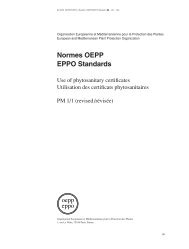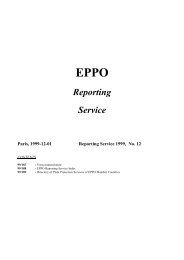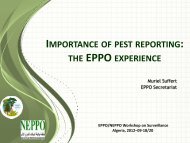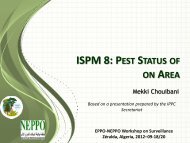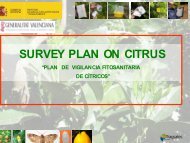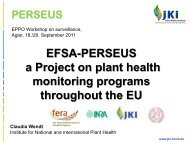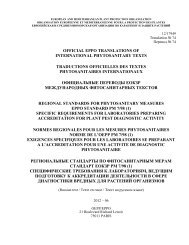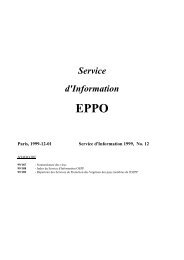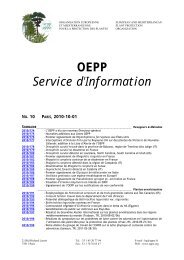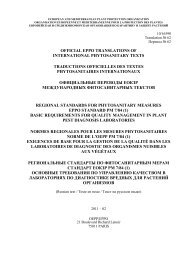Phytoplasma detection and identification: from 16S ribosomal gene ...
Phytoplasma detection and identification: from 16S ribosomal gene ...
Phytoplasma detection and identification: from 16S ribosomal gene ...
Create successful ePaper yourself
Turn your PDF publications into a flip-book with our unique Google optimized e-Paper software.
<strong>Phytoplasma</strong> <strong>detection</strong> <strong>and</strong> <strong>identification</strong>:<br />
<strong>from</strong> <strong>16S</strong> <strong>ribosomal</strong> <strong>gene</strong> to multiple <strong>gene</strong><br />
<strong>identification</strong><br />
Assunta Bertaccini ‐ Samanta Paltrinieri ‐ Nicoletta<br />
Contaldo Jana Franova<br />
Mogens Nicolaisen<br />
Bojan Duduk<br />
DiSTA Plant Pathology ‐ Alma Mater Studiorum University of Bologna, Italy<br />
Biology Centre of the ASCR, Institute of Plant Molecular Biology, Biology,<br />
Department of Plant Virology, Czech<br />
Republic<br />
Department of Agroecology, Agroecology,<br />
Aarhus University, Slagelse, Slagelse,<br />
Denmark<br />
Institute of Pesticides <strong>and</strong> Environmental protection, protection,<br />
Belgrade, Belgrade,<br />
Serbia
● plant pathogenic mycoplasmas that<br />
infect over 700 plant species<br />
● Induce yellowing, stunting, witches’<br />
broom, <strong>and</strong> phyllody<br />
● Non yet culturable <strong>and</strong> classified in<br />
the class Mollicutes<br />
● Cell‐wall‐less, pleomorphic, 0.1~0.8<br />
µm in diameter<br />
● Inhabit phloem <strong>and</strong> emolimph <strong>and</strong><br />
are transmitted by insects <strong>and</strong>…
New ‘C<strong>and</strong>idatus C<strong>and</strong>idatus species’ species must have <strong>16S</strong><br />
rDNA homology lower of 97.5% compared to<br />
those already described<br />
Today 34 species officially described as<br />
‘C<strong>and</strong>idatus’…
‘C<strong>and</strong>idatus <strong>Phytoplasma</strong>’ species Ribosomal group Associated diseases<br />
‘Ca. <strong>Phytoplasma</strong> asteris’ Aster Yellows group (<strong>16S</strong>rI) Aster yellows<br />
‘Ca. <strong>Phytoplasma</strong> japonicum’ Aster Yellows group (<strong>16S</strong>rI) Japanese Hydrangea phyllody<br />
‘Ca. <strong>Phytoplasma</strong> aurantifolia’ Peanut Witches' Broom group (<strong>16S</strong>rII) Acid lime witches’ broom<br />
‘Ca. <strong>Phytoplasma</strong> pruni’ X‐disease (<strong>16S</strong>rIII) Peach X disease<br />
‘Ca. <strong>Phytoplasma</strong> castaneae’ Coconut Lethal Yellowing group (<strong>16S</strong>rIV) Korean chestnut witches' broom<br />
'Ca. <strong>Phytoplasma</strong> pini' Coconut Lethal Yellowing group (<strong>16S</strong>rIV)<br />
‘Ca. <strong>Phytoplasma</strong> ziziphi’ Elm Yellows group (<strong>16S</strong>rV) Ziziphus jujube witches' broom<br />
‘Ca. <strong>Phytoplasma</strong> ulmi’ Elm Yellows group (<strong>16S</strong>rV) Elm yellows<br />
‘Ca. <strong>Phytoplasma</strong> trifolii’ Clover Proliferation group (<strong>16S</strong>rVI) Clover proliferation<br />
‘Ca. <strong>Phytoplasma</strong> fraxini’ Ash Yellows group (<strong>16S</strong>rVII) Ash yellows<br />
‘Ca. <strong>Phytoplasma</strong> phoenicium’ Pigeon Pea Witches' Broom group (<strong>16S</strong>rIX) Almond lethal disease<br />
‘Ca. <strong>Phytoplasma</strong> mali’ Apple Proliferation group (<strong>16S</strong>rX) Apple proliferation<br />
‘Ca. <strong>Phytoplasma</strong> pyri’ Apple Proliferation group (<strong>16S</strong>rX) Pear decline<br />
‘Ca. <strong>Phytoplasma</strong> prunorum’ Apple Proliferation group (<strong>16S</strong>rX) European stone fruit yellows<br />
‘Ca. <strong>Phytoplasma</strong> spartii’ Apple Proliferation group (<strong>16S</strong>rX) Spartium witches’ broom<br />
‘Ca. <strong>Phytoplasma</strong> rhamni’ Apple Proliferation group (<strong>16S</strong>rX) Buckthorn witches’ broom<br />
‘Ca. <strong>Phytoplasma</strong> allocasuarinae Apple Proliferation group (<strong>16S</strong>rX) Allocasuarina yellows<br />
‘Ca. <strong>Phytoplasma</strong> oryzae’ Rice Yellow Dwarf group (<strong>16S</strong>rXI) Rice yellow dwarf<br />
‘Ca. <strong>Phytoplasma</strong> australiense’ Stolbur group (<strong>16S</strong>rXII) Australian grapevine yellows<br />
‘Ca. <strong>Phytoplasma</strong> cynodontis’ BGWL group (<strong>16S</strong>rXIV) Bermuda grass white leaf<br />
‘Ca. <strong>Phytoplasma</strong> brasiliense’ ‘Ca. P. brasiliense’ group (<strong>16S</strong>rXV) Brazilian hibiscus witches' broom<br />
'Ca. <strong>Phytoplasma</strong> graminis' 'Ca. P. graminis' group (<strong>16S</strong>rXVI) Sugarcane yellow leaf <strong>from</strong> Cuba<br />
'Ca. <strong>Phytoplasma</strong> caricae' 'Ca. P. caricae' group (<strong>16S</strong>rXVII) Papaya bunchy top <strong>from</strong> Cuba<br />
'Ca. <strong>Phytoplasma</strong> fragariae' <strong>ribosomal</strong> group not designated Strawberry yellows ‐ Lithuania<br />
'Ca . <strong>Phytoplasma</strong> americanum' 'Ca . P. americanum' (<strong>16S</strong>rXVIII) Potato purple top wilt ‐ USA<br />
'Ca . <strong>Phytoplasma</strong> omanense' 'Ca. P. omanense' (<strong>16S</strong>rXIX) Cassia witches' broom ‐ Oman<br />
'Ca . <strong>Phytoplasma</strong> lycopersici' <strong>ribosomal</strong> group not designated Lycopersicum esculentum ‐ Bolivia<br />
'Ca . <strong>Phytoplasma</strong> rubi' Rubus stunt (<strong>16S</strong>rV‐E) Rubus sp.‐ Italy<br />
'Ca . <strong>Phytoplasma</strong> costaricanum' Soybean stunt (<strong>16S</strong>rXXXI‐A) Soybean stunt<br />
'Ca . <strong>Phytoplasma</strong> tamaricis' Salt cedar trees witches' broom (<strong>16S</strong>rXXX) Salt cedar trees witches' broom ‐ China<br />
'Ca . <strong>Phytoplasma</strong> sudamericanum' Passion fruit witches' broom (<strong>16S</strong>rVI‐I) Passion fruit witches' broom<br />
'Ca . <strong>Phytoplasma</strong> convolvuli' Bindweed yellows (<strong>16S</strong>rXII‐H) Bindweed yellows<br />
'Ca . <strong>Phytoplasma</strong> malaysianum' Periwinkle virescence Virescence <strong>and</strong> phyllody of periwinkle<br />
'Ca . <strong>Phytoplasma</strong> balanitae' Balanites witches' broom Balanites phyllody
‘C<strong>and</strong>idatus <strong>Phytoplasma</strong>’<br />
species<br />
Ribosomal group Associated diseases<br />
[‘Ca. <strong>Phytoplasma</strong> palmae’] Coconut Lethal Yellowing group (<strong>16S</strong>rIV) Coconut lethal yellowing (Mexico)<br />
[‘Ca. <strong>Phytoplasma</strong><br />
Coconut Lethal Yellowing group (<strong>16S</strong>rIV) Coconut lethal yellowing<br />
cocostanzaniae’]<br />
(Tanzania)<br />
[‘Ca. <strong>Phytoplasma</strong> cocosnigeriae’] Coconut Lethal Yellowing group (<strong>16S</strong>rIV) Coconut lethal yellowing (Nigeria)<br />
[‘Ca. <strong>Phytoplasma</strong> vitis’] Elm Yellows group (<strong>16S</strong>rV) Flavescence dorée<br />
[‘Ca. <strong>Phytoplasma</strong> luffae’] Loofah Witches' Broom group (<strong>16S</strong>rVIII) Loofah witches'‐broom<br />
[‘Ca. <strong>Phytoplasma</strong> solani’] Stolbur group (<strong>16S</strong>rXII) Stolbur <strong>and</strong> Bois Noir<br />
Today 8 species NOT officially described as<br />
‘C<strong>and</strong>idatus’…
<strong>16S</strong> <strong>ribosomal</strong> groups<br />
Aster yellows: AY <strong>16S</strong>rI<br />
Peanut witches’ witches broom: broom:<br />
PnWB <strong>16S</strong>rII<br />
Peach X disease: disease:<br />
CX <strong>16S</strong>rIII<br />
Coconut letal yellowing: LY <strong>16S</strong>rIV<br />
Elm yellows: EY <strong>16S</strong>rV<br />
Clover proliferation: CP <strong>16S</strong>rVI<br />
Ash yellows: ASHY <strong>16S</strong>rVII<br />
Loofah witches’ witches broom: broom:<br />
LWB <strong>16S</strong>rVIII<br />
Pigeon pea witches’ witches broom: broom:<br />
PPWB <strong>16S</strong>rIX<br />
Apple proliferation: proliferation:<br />
AP <strong>16S</strong>rX<br />
Rice yellow dwarf: RYD <strong>16S</strong>rXI<br />
Stolbur: STOL <strong>16S</strong>rXII<br />
Mexican periwinkle virescence: MPV <strong>16S</strong>rXIII<br />
Bermudagrass white leaf: BGWL <strong>16S</strong>rXIV<br />
Hibiscus witches’ witches broom: broom:<br />
HiWB <strong>16S</strong>rXV<br />
Sugarcane yellow leaf: leaf:<br />
SCYL <strong>16S</strong>rXVI<br />
Papaya bunchy top: PAY <strong>16S</strong>rXVII<br />
American potato purple top wilt: wilt:<br />
APPTW <strong>16S</strong>rXVIII<br />
Cassia witches’ witches broom: broom:<br />
CaWB <strong>16S</strong>rXIX……<br />
<strong>16S</strong>rXIX……..<br />
..
Full genome sequence<br />
available for 4 strains<br />
2 ‘Ca Ca. . P. asteris’ asteris<br />
1 ‘Ca Ca. . P. australiense’<br />
australiense<br />
1 ‘Ca Ca. . P. mali’<br />
mali
Multiple locus analyses<br />
Elongation factor tuf tuf all<br />
all<br />
Ribosomal protein S3 S3 all*<br />
Nitroreductase <strong>gene</strong> <strong>16S</strong>rX<br />
Rib. Rib Rib. . recycling factor + aminoacid kinase <strong>16S</strong>rI‐A/B <strong>16S</strong>rI <strong>16S</strong>rI‐A/B A/B<br />
Amp/Imp Amp Amp/Imp Imp <strong>gene</strong>s all*<br />
Translocation <strong>gene</strong>s SecA all<br />
all<br />
Translocation <strong>gene</strong>s SecY all*<br />
GroEL <strong>gene</strong>s all*
QBOL‐developed<br />
QBOL developed tuf marker
<strong>Phytoplasma</strong> strains <strong>from</strong> micropropagated<br />
collection<br />
<strong>16S</strong>rI <strong>16S</strong>rII <strong>16S</strong>rIII <strong>16S</strong>rV <strong>16S</strong>rVI <strong>16S</strong>rVII <strong>16S</strong>rX <strong>16S</strong>rXI <strong>16S</strong>rXII <strong>16S</strong>rXV<br />
RFLP on 3% agarose gel
Insect phytoplasma vectors<br />
‘Ca. Ca. P. asteris’ asteris (Europe Europe) <strong>16S</strong>rI‐B <strong>16S</strong>rI B Macrosteles<br />
Macrosteles quadripuctulatus,<br />
quadripuctulatus,<br />
Euscelis spp., spp.,<br />
Euscelidius spp. spp<br />
Mulberry dwarf (Korea Korea) <strong>16S</strong>rI‐D <strong>16S</strong>rI Hishimonoides sellatiformis<br />
Various diseases (Australia) <strong>16S</strong>rII‐D <strong>16S</strong>rII Orosius argentatus<br />
Peach X disease (USA) <strong>16S</strong>rIII‐A <strong>16S</strong>rIII A Paraphlepsius irroratus, irroratus<br />
spp. spp<br />
‘Ca Ca. . P. ulmi’ ulmi (USA) <strong>16S</strong>rV‐A <strong>16S</strong>rV A Scaphoideus caphoideus luteolus (USA)<br />
Grapevine flavescence dorée dor <strong>16S</strong>rV‐C/ <strong>16S</strong>rV C/–D Scaphoideus titanus<br />
‘Ca Ca. . P. mali’ mali<br />
<strong>16S</strong>rX‐A <strong>16S</strong>rX A Cacopsylla costalis, costalis,<br />
C.<br />
‘Ca Ca. . P. prunorum’ prunorum<br />
<strong>16S</strong>rX‐B <strong>16S</strong>rX C. pruni<br />
‘Ca Ca. . P. pyri’ pyri<br />
<strong>16S</strong>rX‐C <strong>16S</strong>rX C C.<br />
Grapevine bois noir <strong>16S</strong>rXII‐A <strong>16S</strong>rXII A Hyalestes<br />
Suger beet stolbur <strong>16S</strong>rXII‐A <strong>16S</strong>rXII A Pentastiridius<br />
, Colladonus<br />
melanoneura,<br />
melanoneura,<br />
Fieberiella florii<br />
C. pyri, pyri,<br />
C. pyricola e C. pyritsuga<br />
Hyalestes obsoletus, obsoletus,<br />
Reptalus spp. spp<br />
Pentastiridius beierii
Identification of phytoplasma strains associated<br />
with epidemic diseases: flavescence dorée
RFLP with TaqI Taq on <strong>16S</strong>r DNA amplicons
FD‐C<br />
Liguria (I)<br />
Tuscany (I)<br />
Serbia<br />
FD‐C<br />
Serbia<br />
Serbia<br />
Serbia<br />
Tuscany (I)<br />
FD‐D<br />
France<br />
Spain<br />
Emilia (I)<br />
Veneto (I)<br />
FD‐70 FD 70 France<br />
France<br />
Emilia (I)
GroELI <strong>gene</strong> ‐ ‘Ca. P. asteris’ (<strong>16S</strong>rI)<br />
group<br />
270 bp 1610 bp 701 bp 392 bp<br />
groES groEL amp nadE<br />
AYgroelF AYgroelR<br />
(22 ‐ 40) (1399 ‐ 1418)
<strong>Phytoplasma</strong> strains <strong>from</strong><br />
micropropagated collection
Strain differentiation<br />
below the <strong>16S</strong>r<br />
subgroup level
Nested PCR primers<br />
270bp 1610bp 701bp 392bp<br />
groES groEL amp nadE<br />
AYgroelF AYgroelR<br />
(22‐40) (1399 ‐ 1418)<br />
AYgroesF<br />
(96‐115)<br />
AYampR<br />
(46‐65)
Samples Lettuce<br />
yellows<br />
(Imperia)<br />
Onion<br />
phyllody<br />
<strong>and</strong><br />
virescence<br />
Sensitivity<br />
Onion<br />
phyllody<br />
<strong>and</strong><br />
virescence<br />
Cabbage<br />
4<br />
phyllody<br />
Cabbage<br />
1<br />
phyllody<br />
Periwinkle<br />
virescence<br />
(Ferrara)<br />
Periwinkle<br />
virescence<br />
(Torino)<br />
Periwinkle<br />
virescence<br />
(Saint Louis)<br />
USA<br />
Year of<br />
extraction<br />
1992 1994 1994 1994 1994 1998 1998 1994<br />
<strong>16S</strong>rDNA group I‐B I‐B I‐B I‐B I‐B I‐B I‐B I‐B<br />
groELI group III III IV I XI III III X<br />
Direct<br />
PCR<br />
Nested<br />
PCR<br />
+ ‐ ‐ ‐ ‐ ‐+ ‐ ‐ ‐<br />
+ + + + + + + +
Field‐collected samples<br />
<strong>Phytoplasma</strong> disease Geographical location<br />
Number of tested<br />
samples (year)<br />
Grouping<br />
TruI AluI groELI <strong>16S</strong>rI<br />
Papaver virescence Forlì (Italy) 1 (2009) 1 1 III ‐B<br />
Oil seed rape phyllody Padova (Italy) 6 (2009) 1 1 III ‐B<br />
Onion phyllody <strong>and</strong><br />
virescence<br />
Potenza (Italy) 4 (1994)<br />
1<br />
2<br />
1<br />
2<br />
III<br />
IV<br />
‐B<br />
‐B<br />
Cabbage phyllody Ravenna (Italy) 6 (1994)<br />
1<br />
7<br />
1<br />
1<br />
III<br />
XI<br />
‐B<br />
Lettuce yellows Florence (Italy) 1 (2000) 1 1 III ‐B<br />
Lettuce yellows Imperia (Italy) 5 (1992) 1 1 III ‐B<br />
Oil palm ‘machite lethal’ Colombia 1 (2004) 2 8 V ‐B<br />
Maize bushy stunt Palmira (Colombia) 2 (2007) 2 8 V ‐B<br />
Periwinkle virescence Belgrade (Serbia) 2 (2010) 4 4 VI ‐C<br />
Periwinkle virescence Torino (Italy) 1 (1998) 1 1 III ‐B<br />
Periwinkle virescence Saint Louis, USA 1 (1994) 1 9 X ‐B<br />
Periwinkle virescence Ferrara (Italy) 1 (1998) 1 1 III ‐B<br />
Carrot proliferation Begeč (Serbia) 3 (2006)<br />
Populus decline Belgrade (Serbia) 1 (2009) 6 7 IX ‐P<br />
Grindelia virescence Ravenna (Italy) 1 (2008) 2 2 IV ‐B<br />
1<br />
2<br />
3<br />
1<br />
2<br />
3<br />
III<br />
IV<br />
I<br />
‐B<br />
?<br />
‐A
ML variability in<br />
apple proliferation<br />
‘Ca. P. mali’<br />
strains (<strong>16S</strong>rX‐A)<br />
Support
Serbia/Hungary<br />
Italy<br />
Strain<br />
acronyms<br />
Primers<br />
F1/B6<br />
HpaII FauI<br />
Group<br />
Primers<br />
AP13/AP10<br />
RcaI HincII<br />
Group<br />
Primers<br />
rpAP15f/rpAP15r<br />
AluI<br />
Group<br />
H-1 - - nd A A AT2 A rpX-A<br />
H-2 A+B A PI+PII - - nd A rpX-A<br />
H-3 B A PII B B AP A rpX-A<br />
H-4 A+B A PI+PII B A AT1 A rpX-A<br />
H-5 A+B A PI+PII B B AP A rpX-A<br />
H-6 A A PI B B AP A rpX-A<br />
RS-135 A A PI B B AP A rpX-A<br />
RS-151 A A PI B B AP A rpX-A<br />
I-VE11 B A PII - - nd C rpX-C<br />
I-VE12 A A PI - - nd A rpX-A<br />
I-VE14 A A PI A A AT2 A rpX-A<br />
I-VE16 B A PII B A AT1 C rpX-C<br />
I-VE22 B A PII - - nd D rpX-D<br />
I-VE27 B A PII B A AT1 D rpX-D<br />
I-VE28 B A PII - - nd D rpX-D<br />
I-VE30 B A PII - - nd D rpX-D<br />
I-VE31 B A PII - - nd D rpX-D<br />
I-VE32 B A PII - - nd D rpX-D<br />
I-VE34 B A PII - - nd D rpX-D<br />
I-TN1 A A PI A A AT2 A rpX-A<br />
I-TN2 A A PI - - nd A rpX-A<br />
I-TN3 B A PII - B nd B rpX-B<br />
AP-15 A A PI B B AP A rpX-A<br />
AT-1 A A PI B A AT1 B rpX-B<br />
AT-2 A A PI A A AT2 A rpX-A
Apple proliferation in the Czech Republic
East Bohemia 1<br />
East Bohemia 2<br />
East Bohemia 2<br />
East Bohemia 3<br />
East Bohemia 3<br />
East Bohemia 4<br />
East Bohemia 4<br />
East Bohemia 5<br />
East Bohemia 5<br />
East Bohemia 6<br />
East Bohemia 6<br />
East Bohemia 6<br />
East Bohemia 6<br />
East Bohemia 6<br />
East Bohemia 6<br />
East Bohemia 6<br />
East Bohemia 6<br />
East Bohemia 6<br />
East Bohemia 6<br />
East Bohemia 6<br />
East Bohemia 6<br />
East Bohemia 7<br />
East Bohemia 7<br />
East Bohemia 7<br />
<strong>16S</strong>‐23S profile<br />
P‐I<br />
P‐I<br />
P‐I<br />
P‐I<br />
P‐I<br />
P‐I<br />
P‐I<br />
P‐I<br />
P‐I<br />
P‐I<br />
P‐I<br />
P‐I<br />
P‐I<br />
P‐I<br />
P‐I<br />
P‐I<br />
P‐I<br />
P‐I<br />
P‐I+P‐I<br />
P‐I+P‐II<br />
P‐I+P‐II<br />
P‐I<br />
P‐I+ P‐II<br />
P‐I+P‐II<br />
AP‐15<br />
AT‐2<br />
AT‐2<br />
AT‐2<br />
AT‐2<br />
AT‐2<br />
AP‐15<br />
AT‐2<br />
AT‐2<br />
AT‐2<br />
AP‐15<br />
AP‐15<br />
AP‐15<br />
AT‐1+AT‐2+AP‐15<br />
AP‐15<br />
AT‐1<br />
AP‐15<br />
AP‐15<br />
AT‐2<br />
AT‐1<br />
AT‐2<br />
AP‐15<br />
AP‐15<br />
AT‐2<br />
AP subtype<br />
rp X‐A<br />
rp X‐A<br />
rp X‐A<br />
rp X‐A<br />
rp X‐A<br />
rp X‐A<br />
rp X‐A<br />
rp X‐A<br />
rp X‐A<br />
rp X‐A<br />
rp X‐A<br />
rp X‐A<br />
rp X‐A<br />
rp X‐A<br />
rp X‐A<br />
rp X‐A<br />
rp X‐A<br />
rp X‐A<br />
rp X‐A<br />
rp X‐A<br />
rp X‐A<br />
rp X‐A<br />
rp X‐A<br />
rp X‐A<br />
rp subgroup
http://ipwgnet.org<br />
http://<br />
Collection of in micropropagated<br />
periwinkle <strong>and</strong> other species of<br />
worldwide<br />
phytoplasma strains<br />
ipwgnet.org Plant pathology ‐ Alma Mater Studiorum University of Bologna Italy




